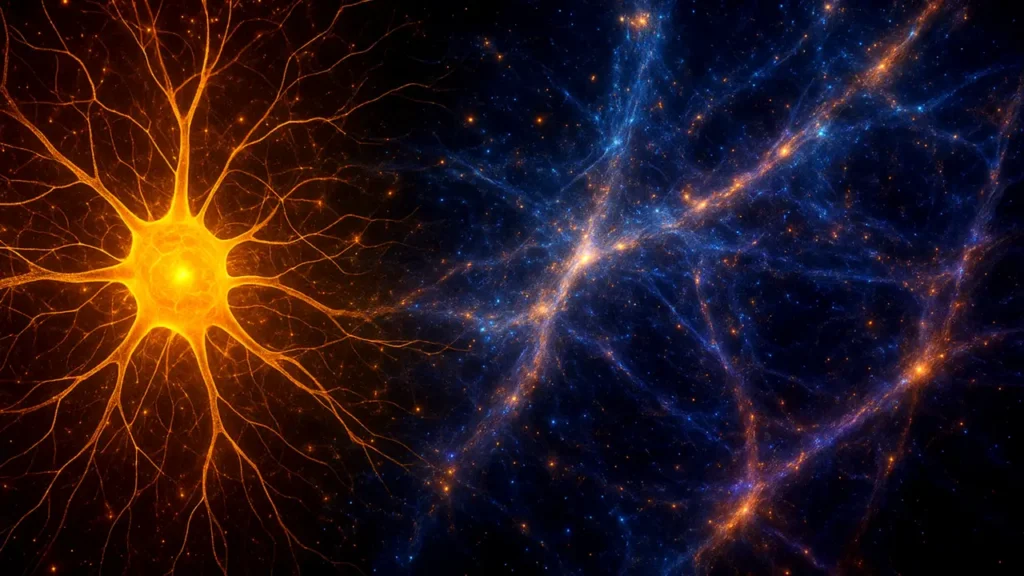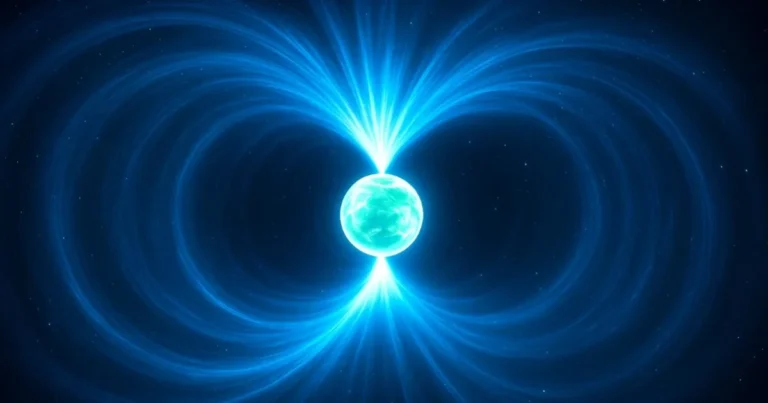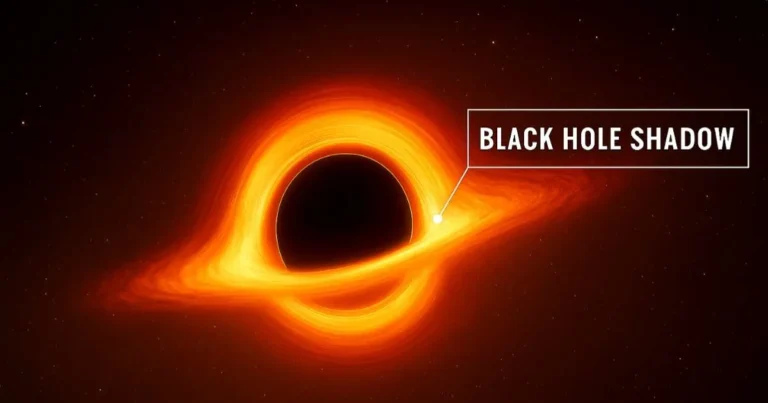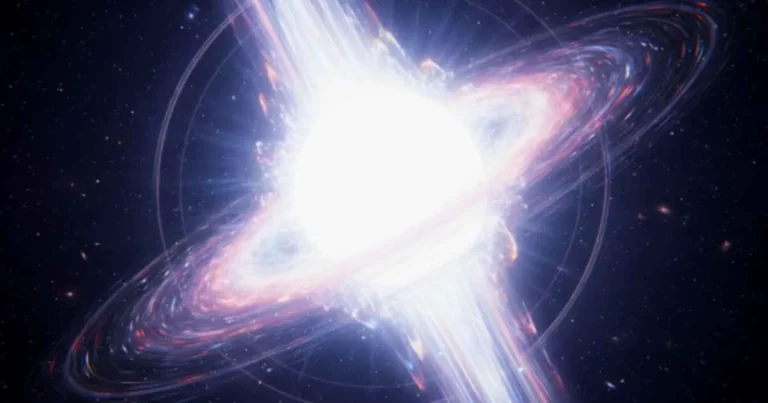The Cosmic Brain Mystery: Are We Living Inside One?

Tags:
- brain vs universe
- cosmic brain theory
- Cosmic Filaments
- Dark Matter
- Stellar Illusion
- universe neural network
You know that weird moment when you stare at the stars and suddenly feel… small? Not just physically — I’m talking existentially small. Like maybe, just maybe, you’re part of something way bigger, and you’re not entirely sure what it is.
Now imagine this:
What if I told you that the entire universe — Galaxies, Dark Matter, everything — might actually look and behave like the inside of a gigantic cosmic brain?
Not science fiction. Actual research. Real data.
Welcome to one of the strangest scientific questions nobody can fully answer yet: Are we living inside a cosmic brain?
Remember how, in our last blog post — “Cosmic Filaments – The Universe’s Neural Network” — we dived into the massive web of galaxies holding the cosmos together like some kind of giant skeleton?
That same concept now opens the door to a seriously mind-bending question:
What if this cosmic web isn’t just a structure… what if it’s behaving like a brain?
It’s no longer stoner lingo or Reddit conspiracy theories anymore. There’s math and physics creeping in, slowly backing that question up. And honestly, it’s kind of incredible and a little unsettling.
The Cosmic Web: Nature’s Blueprint at Scale
Just in case you missed the earlier article on Cosmic Web — (you should totally check it out) — let’s quickly rewind. The cosmic web is this massive structure where galaxies, clusters, dark matter, and gas stretch across the universe like a tangled spider’s web. It’s beautiful, chaotic, yet scarily organized. Think of it like:
- Galactic highways (called filaments) connecting cities (galaxy clusters).
- Cosmic voids — vast empty regions, like deserts between the towns.
- Dark matter scaffolding — invisible bones holding it all together, shaping how matter clumps across billions of light-years. If you want to go deeper into the hidden forces shaping this web, I broke down some of the wildest facts in another post → check it out here.
When astronomers chart this network, the result on their screens strangely resembles a human brain scan. No joke.
I mean glowing tendrils, intersections, networks branching into networks — it’s like focusing in on your own neurons under a microscope, but instead of electrical impulses, there are galaxies flowing down those channels.
Coincidence?
Perhaps.
But that’s where Franco Vazza and Alberto Feletti stepped in with actual data.
Scientific Research Behind the “Cosmic Brain”
In 2020, these two (an astrophysicist and a neuroscientist, because of course the two of them getting together equals nutty conversations) teamed up and compared actual MRI scans of the human brain with computer simulations of the cosmic web.
Here’s what they found:
- Scale-free Networks: Both expand by adding smaller to larger components. Same pattern, different ingredients.
- Density Patterns:
- Neurons = ~80 billion in your brain.
- Galaxies = ~2 trillion in observable universe.
Yet, their distribution of clustering was very regular throughout.
Even cooler? When they analyzed how information or matter moves inside these two systems, the pathways — the logic of connections — showed statistical overlap around 70%.
Now, that doesn’t say that your brain is going to create a spiral galaxy. But it does demonstrate that nature’s process of ordering complexity is not size-dependent.
That’s fractal behavior. Small mirrors large. Patterns repeat across sizes and systems.
Could the Universe Be. Conscious?
Okay, now for the best part.
Does that imply that the universe is able to think? Might you, at the moment, be reading these words somewhere in some cosmic thought?
Depends on who you ask.
- Panpsychism → There’s this argument going on that everything — all right, everything — has a spark of consciousness. Even rocks. Even atoms. Even, perhaps, galaxies.
- Simulation Theory → And then there’s the reality school of thought that says it’s programmed. If you’ve got programmers, then you’ve got data structures. The universe may just be one gigantic hyper-intelligent neural network running its own processes.
- Emergent Complexity → Others play it safe. Perhaps, when things get big enough and complicated enough, strange things occur. Unfamiliar emergent behaviors. Such as slime mold navigating mazes or ants like a single brain acting together.
Now, scientifically, there’s no direct proof the universe is conscious. Even Franco Vazza himself stated:
“Even though the physical systems that control the two systems are totally different, the levels of complexity and self-organization are remarkably equivalent.”
Translation: It looks like a brain, but don’t go naming the universe Jeff just yet.
It’s crazy, right? But honestly, before we even get to cosmic consciousness, we’ve got our own limitations to deal with → check out The Cognitive Limits of Human Astronomy.
More Than Just Science — It’s Philosophy Too
What makes this idea powerful isn’t just science — it’s the philosophy it allows. This is not the first time humans have gazed upon the universe and asked whether it is alive.
- Hindu scriptures define Brahman, a universal consciousness.
- The Stoics referred to the “Logos,” a sagacious order making up the universe.
- Even modern physicists like Sean Carroll entertain ideas of universal information fields, but not exactly consciousness.
Look. There’s the thread.
Each generation gazes up at the stars and somehow manages to wonder whether the stars are gazing at them.
Patterns Within Patterns — Fractals Everywhere
Here’s another thing that’s been floating around in my brain: Fractals.
The vein structure of a leaf is similar to a river system. Rivers resemble lightning bolts. Lightning resembles blood vessels. Blood vessels resemble… surprise, surprise. Cosmic filaments. Patterns inside patterns. Nature is lazy — it doesn’t invent new blueprints when old ones work perfectly fine.
So perhaps neurons ought to resemble galaxies. Perhaps it’s merely recursion at a scale we’re not yet able to comprehend.
Why This Is More Than Just a Fun Thought
You’re likely wondering — Why does this matter? Here’s why:
- It indicates that everything is interconnected. You are literally constructed on the same template as the stars.
- It keeps science open. The best discoveries often begin with seemingly ridiculous ideas.
- It provokes questions. And come on — curiosity’s why you’re reading astronomy blogs on Stellar Illusion at midnight in the first place.
We don’t know if the universe thinks. We don’t even know what thinking is yet.
But what we do know is that your structure and the structure of the universe are mirror images of the very same universal principles. And that? That’s wild.
Final Thought: Perhaps The Universe Is Curious About Us, Too
I mean, I’m not claiming we’re in somebody’s brain.
But “I’m not outright claiming it’s true… but I’m also not denying it completely.”
For the time being, we are neurons firing thoughts into the void, gazing into limitless space, questioning if space is questioning us too. Funny how the deeper we go out there, the more it starts to feel like we’re just diving deeper… into ourselves.
Comments
Please log in to leave a comment.
Related Posts

Magnetar: The Universe’s Most Extreme Magnetic Monster
Magnetars are ultra-magnetic neutron stars, cosmic beasts that emit bursts of radiation so powerful they can shake entire galaxies. Learn how they form, what makes them unique, and why their mystery continues to fascinate astronomers.

What Is a Black Hole Shadow? The Ultimate Glimpse into the Abyss
If you could stare into the heart of a galaxy, past the light, past the stars, and into pure darkness, what would you actually see? When astronomers talk about the black hole shadow, they’re referring to one of the most mind-bending sights in the universe, the silhouette of the unseeable, the faint outline of where […]

White Holes: The Universe’s Reverse Gear
If we were to rank the theories that have changed human history forever, the General Theory of Relativity would be at the top. The results it reveals are beyond human understanding. They show that the cosmos is filled with perplexing phenomena, some of which are purely hypothetical yet mathematically elegant. One such phenomenon is the […]